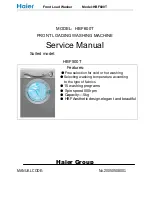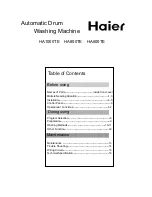
14
15
KDW4752N
EN
dishwasher
Connecting the water and electricity supplies
Connection to the water and electricity supplies should only be
performed by a qualified technician.
The dishwasher should not stand on top of the water hoses or
the electricity supply cable.
The appliance is to be connected to the water mains using new
hose sets and the old hose-sets should not be reused.
Connecting the water inlet hose
Connect the cold water supply hose to a
threaded ¾ (inch) connector and make
sure that it is fastened tightly in place.
If the water pipes are new or have not
been used for an extended period of
time, let the water run to make sure that
the water is clear and free of impurities.
If this precaution is not taken, there is a
risk that the water inlet can get blocked
and the appliance could be damaged.
Connecting the water outlet hose
Fit your dishwasher’s drainage hose to
the drainage pipe without bending it.
Remember that the length of the hose
should not exceed 4 meters even with
an extension.
If the drainage hose is longer the
4 m, the dishes will not be cleaned
properly. Secure your hose firmly to
the drainage pipe to avoid it coming off
during the washing process.
Electrical connection
Before inserting the plug into the electrical socket, make sure:
• the socket is earthed and complies with current regulations;
• the socket can withstand the maximum load of the appliance, which
is indicated on the data plate located on the inside of the door (see
description of the appliance);
• the power supply voltage falls within the values indicated on the
data plate on the inside of the door;
• the socket is compatible with the plug of the appliance. If this is not
the case, ask an authorized technician to replace the plug (contact
the Customer Support Service); do not use extension cables or
multiple sockets.
Once the appliance has been installed, the power supply cable
and the electrical socket should be easily accessible.
The cable should not be bent or compressed.
If the power supply cable is damaged, it must be replaced by the
manufacturer or its Customer Support Service in order to prevent all
potential hazards.
The company shall not be held responsible for any incidents that
occur if these regulations are not observed.
Advice regarding the first washing programme
After the appliance has been installed, immediately before running
the first washing programme, completely fill the salt dispenser and
add approximately 2 Kg of salt (refer to section “Salt, Detergent
and Rinse Aid”). The water may overflow: this is normal and is not a
cause for concern. It is also normal that the LOW SALT indicator light
continues to flash for a few cycles after the salt has been loaded.
Positioning the Appliance
Position the appliance in the desired location. The back should rest
against the wall behind it, and the sides, along the adjacent cabinets
or wall. The dishwasher is equipped with water supply and drain
hoses that can be positioned to the right or the left to facilitate proper
installation.
Levelling the Appliance
Once the appliance is positioned, adjust the feet (screwing them in
or out) to adjust the height of the dishwasher, making it level. In any
case, the appliance should not be inclined more than 2°.
NOTE:
the maximum adjustment height of the feet is 20 mm.
How to drain excess water from hoses
If the sink is 1000 mm higher from the floor, the excess water in the
hoses cannot be drained directly into the sink. It will be necessary to
drain the excess water from the hoses into a bowl or into a suitable
container that is held outside and lower than the sink.
Water outlet
Connect the water drain hose. The drain hose must be correctly fitted
to avoid water leaks. Ensure that the water inlet hose is not kinked
or squashed.
Extension hose
If you need a drain hose extension, try to use a similar drain hose, no
longer than 4 metres; otherwise the cleaning effect of the dishwasher
could be reduced.









































